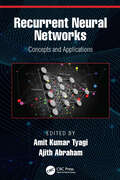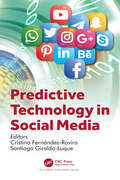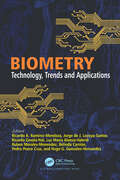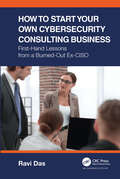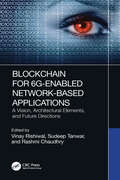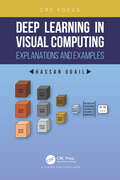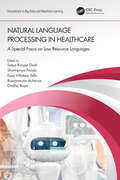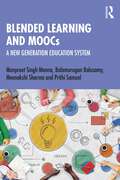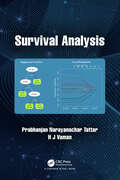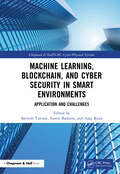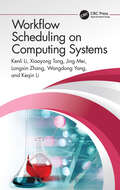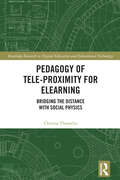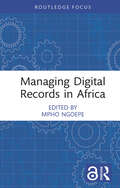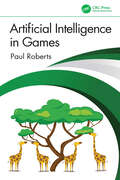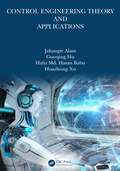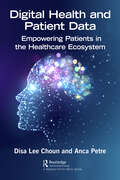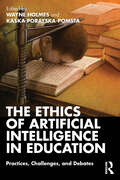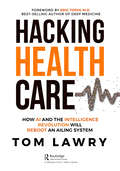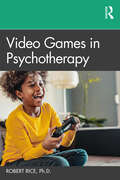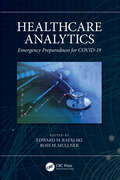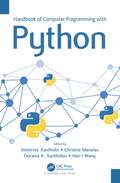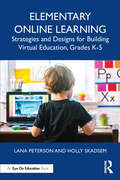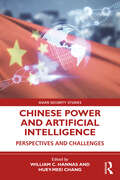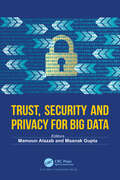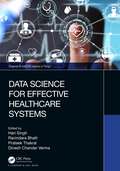- Table View
- List View
Recurrent Neural Networks: Concepts and Applications
by Ajith Abraham Amit Kumar TyagiThe text discusses recurrent neural networks for prediction and offers new insights into the learning algorithms, architectures, and stability of recurrent neural networks. It discusses important topics including recurrent and folding networks, long short-term memory (LSTM) networks, gated recurrent unit neural networks, language modeling, neural network model, activation function, feed-forward network, learning algorithm, neural turning machines, and approximation ability. The text discusses diverse applications in areas including air pollutant modeling and prediction, attractor discovery and chaos, ECG signal processing, and speech processing. Case studies are interspersed throughout the book for better understanding. FEATURES Covers computational analysis and understanding of natural languages Discusses applications of recurrent neural network in e-Healthcare Provides case studies in every chapter with respect to real-world scenarios Examines open issues with natural language, health care, multimedia (Audio/Video), transportation, stock market, and logistics The text is primarily written for undergraduate and graduate students, researchers, and industry professionals in the fields of electrical, electronics and communication, and computer engineering/information technology.
Predictive Technology in Social Media
by Cristina Fernández-RoviraCan behaviour on social media predict future purchase patterns? Can what we click on social media foresee which political party will we vote for? Can the information we share on our wall foretell the next series I might want to watch? Can the likes on Instagram and Facebook predict the time one will spend on digital platforms in the next hour? The answer is no longer science fiction. It points to the ability of mainstream social media platforms such as Facebook and Twitter to be able to deliver specialised advertising services to highly targeted audience segments controlled by the billions of devices that flood our daily lives. At the same time, it highlights a more relevant problem: can social media guide, suggest or impose a certain behaviour or thought? Everything seems to indicate that they can do it.Predictive Technology in Social Media comprises 10 essays that reflect on the power of the predictive technology of social media in culture, entertainment, marketing, economics and politics. It shows, from a humanistic and critical perspective, the predictive possibilities of social media platforms, as well as the risks this entails for cultural plurality, everyday consumption, the monopolistic concentration of the economy and attention, and democracy. The text is an invitation to think, as citizens, about the unbridled power we have ceded to digital platforms. A new voice to warn about the greatest concentration of communicative power ever seen in the history of humanity.
Biometry: Technology, Trends and Applications
by Ricardo A. Ramirez-Mendoza, Jorge de J. Lozoya-Santos, Ricardo Zavala-Yoé, Luz María Alonso-Valerdi, Ruben Morales-Menendez, Belinda Carrión, Pedro Ponce Cruz and Hugo G. Gonzalez-HernandezBiometrics provide quantitative representations of human features, physiological and behavioral. This book is a compilation of biometric technologies developed by various research groups in Tecnologico de Monterrey, Mexico. It provides a summary of biometric systems as a whole, explaining the principles behind physiological and behavioral biometrics and exploring different types of commercial and experimental technologies and current and future applications in the fields of security, military, criminology, healthcare education, business, and marketing. Examples of biometric systems using brain signals or electroencephalography (EEG) are given. Mobile and home EEG use in children’s natural environments is covered. At the same time, some examples focus on the relevance of such technology in monitoring epileptic encephalopathies in children. Using reliable physiological signal acquisition techniques, functional Human Machine Interfaces (HMI) and Brain-Computer Interfaces (BCI) become possible. This is the case of an HMI used for assistive navigation systems, controlled via voice commands, head, and eye movements. A detailed description of the BCI framework is presented, and applications of user-centered BCIs, oriented towards rehabilitation, human performance, and treatment monitoring are explored. Massive data acquisition also plays an essential role in the evolution of biometric systems. Machine learning, deep learning, and Artificial Intelligence (AI) are crucial allies here. They allow the construction of models that can aid in early diagnosis, seizure detection, and data-centered medical decisions. Such techniques will eventually lead to a more concise understanding of humans.
How to Start Your Own Cybersecurity Consulting Business: First-Hand Lessons from a Burned-Out Ex-CISO
by Ravi DasThe burnout rate of a Chief Information Security Officer (CISO) is pegged at about 16 months. In other words, that is what the average tenure of a CISO is at a business. At the end of their stay, many CISOs look for totally different avenues of work, or they try something else – namely starting their own Cybersecurity Consulting business. Although a CISO might have the skill and knowledge set to go it alone, it takes careful planning to launch a successful Cyber Consulting business. This ranges all the way from developing a business plan to choosing the specific area in Cybersecurity that they want to serve. How to Start Your Own Cybersecurity Consulting Business: First-Hand Lessons from a Burned-Out Ex-CISO is written by an author who has real-world experience in launching a Cyber Consulting company. It is all-encompassing, with coverage spanning from selecting which legal formation is most suitable to which segment of the Cybersecurity industry should be targeted. The book is geared specifically towards the CISO that is on the verge of a total burnout or career change. It explains how CISOs can market their experience and services to win and retain key customers. It includes a chapter on how certification can give a Cybersecurity consultant a competitive edge and covers the five top certifications in information security: CISSP, CompTIA Security+, CompTIA CySA+, CSSP, and CISM. The book’s author has been in the IT world for more than 20 years and has worked for numerous companies in corporate America. He has experienced CISO burnout. He has also started two successful Cybersecurity companies. This book offers his own unique perspective based on his hard-earned lessons learned and shows how to apply them in creating a successful venture. It also covers the pitfalls of starting a consultancy, how to avoid them, and how to bounce back from any that prove unavoidable. This is the book for burned-out former CISOs to rejuvenate themselves and their careers by launching their own consultancies.
Blockchain for 6G-Enabled Network-Based Applications: A Vision, Architectural Elements, and Future Directions
by Sudeep Tanwar Vinay Rishiwal Rashmi ChaudhryThis book provides a comprehensive overview of blockchain for 6G-enabled network-based applications. Following the key services of blockchain technology, this book will be instrumental to ideate and understand the necessities, challenges, and various case studies of different 6G-based applications. The emphasis is on understanding the contributions of blockchain technology in 6G-enabled applications, and its aim is to give insights into evolution, research directions, challenges, and the ways to empower 6G applications through blockchain. The book consistently emphasizes the missing connection between blockchain and 6G-enabled network applications. The entire ecosystem between these two futuristic technologies is explained in a comprehensive manner. The book constitutes a one-stop guide to students, researchers, and industry professionals. The book progresses from a general introduction toward more technical aspects while remaining easy to understand throughout. Comprehensive elaboration of material is supplemented with examples and diagrams, followed by easily understandable approaches with regard to technical information given thereon. Blockchain and its applications in 6G-enabled applications can drive many powerful solutions to real-world technical, scientific, and social problems. This book presents the most recent and exciting advances in blockchain for 6G-enabled network applications. Overall, this book is a complete outlet and is designed exclusively for professionals, scientists, technologists, developers, designers, and researchers in network technologies around blockchain integration with IoT, blockchain technology, information technology, and 6G-enabled industrial applications. Secondary readers include professionals involved in policy making and administration, security of public data and law, network policy developers, blockchain technology experts, regulators, and decision makers in government administrations.
Deep Learning in Visual Computing: Explanations and Examples
by Hassan UgailDeep learning is an artificially intelligent entity that teaches itself and can be utilized to make predictions. Deep learning mimics the human brain and provides learned solutions addressing many challenging problems in the area of visual computing. From object recognition to image classification for diagnostics, deep learning has shown the power of artificial deep neural networks in solving real world visual computing problems with super-human accuracy. The introduction of deep learning into the field of visual computing has meant to be the death of most of the traditional image processing and computer vision techniques. Today, deep learning is considered to be the most powerful, accurate, efficient and effective method with the potential to solve many of the most challenging problems in visual computing. This book provides an insight into deep machine learning and the challenges in visual computing to tackle the novel method of machine learning. It introduces readers to the world of deep neural network architectures with easy-to-understand explanations. From face recognition to image classification for diagnosis of cancer, the book provides unique examples of solved problems in applied visual computing using deep learning. Interested and enthusiastic readers of modern machine learning methods will find this book easy to follow. They will find it a handy guide for designing and implementing their own projects in the field of visual computing.
Natural Language Processing In Healthcare: A Special Focus on Low Resource Languages (Innovations in Big Data and Machine Learning)
by Biswaranjan Acharya Satya Ranjan Dash Shantipriya Parida Esaú Villatoro Tello Ondřej BojarNatural Language Processing In Healthcare: A Special Focus on Low Resource Languages covers the theoretical and practical aspects as well as ethical and social implications of NLP in healthcare. It showcases the latest research and developments contributing to the rising awareness and importance of maintaining linguistic diversity. The book goes on to present current advances and scenarios based on solutions in healthcare and low resource languages and identifies the major challenges and opportunities that will impact NLP in clinical practice and health studies.
Blended Learning and MOOCs: A New Generation Education System
by Balamurugan Balusamy Meenakshi Sharma Manpreet Singh Manna Prithi SamuelThis book presents a framework for integrating blended learning and massive open online courses (MOOCs) in the Indian education system. It argues that blended teaching and learning is the most suitable approach to education in a post-COVID-19 world. Drawing on case studies used in blended learning practices around the world, the book provides ample resources for beginners to improvise the spread of knowledge around information technology in higher education. It discusses various concepts such as flip learning in blended learning models and examines the self-assessment tools and structures it offers to institutions for building competencies. In addition to addressing the challenges and opportunities of adopting the digital mode of teaching, the book also offers techniques and concepts helpful for designing MOOCs. It covers concepts such as curriculum designing, content flow, teaching behavior, and evaluation patterns, which are important aspects of online teaching. An indispensable guide to navigating the shift from offline to online teaching, this book will be of interest to students, teachers, and researchers of education, education technology, digital education, and information technology. It will also be useful to policymakers, educational institutions, EdTech start-ups, NGOs in the education sector, and online education centers.
Survival Analysis
by Prabhanjan Tattar H J VamanSurvival analysis generally deals with analysis of data arising from clinical trials. Censoring, truncation, and missing data create analytical challenges and the statistical methods and inference require novel and different approaches for analysis. Statistical properties, essentially asymptotic ones, of the estimators and tests are aptly handled in the counting process framework which is drawn from the larger arm of stochastic calculus. With explosion of data generation during the past two decades, survival data has also enlarged assuming a gigantic size. Most statistical methods developed before the millennium were based on a linear approach even in the face of complex nature of survival data. Nonparametric nonlinear methods are best envisaged in the Machine Learning school. This book attempts to cover all these aspects in a concise way. Survival Analysis offers an integrated blend of statistical methods and machine learning useful in analysis of survival data. The purpose of the offering is to give an exposure to the machine learning trends for lifetime data analysis. Features: Classical survival analysis techniques for estimating statistical functional and hypotheses testing Regression methods covering the popular Cox relative risk regression model, Aalen’s additive hazards model, etc. Information criteria to facilitate model selection including Akaike, Bayes, and Focused Penalized methods Survival trees and ensemble techniques of bagging, boosting, and random survival forests A brief exposure of neural networks for survival data R program illustration throughout the book
Machine Learning, Blockchain, and Cyber Security in Smart Environments: Application and Challenges (Chapman & Hall/CRC Cyber-Physical Systems)
by Ajay Rana Sarvesh Tanwar Sumit BadotraMachine Learning, Cyber Security, and Blockchain in Smart Environment: Application and Challenges provides far-reaching insights into the recent techniques forming the backbone of smart environments, and addresses the vulnerabilities that give rise to the challenges in real-word implementation. The book focuses on the benefits related to the emerging applications such as machine learning, blockchain and cyber security. Key Features: • Introduces the latest trends in the fields of machine learning, blockchain and cyber security • Discusses the fundamentals, challenges and architectural overviews with concepts • Explores recent advancements in machine learning, blockchain, and cyber security • Examines recent trends in emerging technologies This book is primarily aimed at graduates, researchers, and professionals working in the areas of machine learning, blockchain, and cyber security.
Workflow Scheduling on Computing Systems
by Kenli Li Keqin Li Xiaoyong Tang Jing Mei Longxin Zhang Wangdong YangThis book will serve as a guide in understanding workflow scheduling techniques on computing systems such as Cluster, Supercomputers, Grid computing, Cloud computing, Edge computing, Fog computing, and the practical realization of such methods. It offers a whole new perspective and holistic approach in understanding computing systems’ workflow scheduling. Expressing and exposing approaches for various process-centric cloud-based applications give a full coverage of most systems’ energy consumption, reliability, resource utilization, cost, and application stochastic computation. By combining theory with application and connecting mathematical concepts and models with their resource management targets, this book will be equally accessible to readers with both Computer Science and Engineering backgrounds.It will be of great interest to students and professionals alike in the field of computing system design, management, and application. This book will also be beneficial to the general audience and technology enthusiasts who want to expand their knowledge on computer structure.
Pedagogy of Tele-Proximity for eLearning: Bridging the Distance with Social Physics (Routledge Research in Digital Education and Educational Technology)
by Chryssa ThemelisThis book examines networked science and the pedagogy of tele-proximity, a paradigm that integrates eLearning theories, information technology and visual media competencies. The book conceptualises the idea of tele-proximity as a means to foster diversity and human to human contact online. It uses the lens of social physics and considers how to bridge the distance in eLearning, examining social connections, collective intelligence and personal wellbeing. The book draws on qualitative and quantitative research in higher education to form fine-tuned eLearning networks that achieve demosophia, the core of democracy. It charts the progress of technology-enhanced learning approaches and shows the need for a sound pedagogical framework that is holistic and sustainable to promote mindful presence. Contributing to the literature on eLearning, this timely book will be of great interest to educational philosophers, policy makers, educators, researchers and students in the field of distance education.
Managing Digital Records in Africa
by Mpho NgoepeManaging Digital Records in Africa draws on the research work of the InterPARES Trust (ITrust) project that investigated interrelated archival issues focusing on legal analysis, infrastructure, trust, authentication, and education within the African context. This research-focused book provides a legal analysis and systematic assessment of how African institutions manage digital records in four countries (i.e., Botswana, Kenya, South Africa, and Zimbabwe). It also examines the extent to which records are managed using Internet-based applications, trust in such records, and digital record authentication to support the auditing process. Finally, it provides a curriculum analysis in digital records at institutions of higher learning in 38 African countries. The book's case studies illustrate the threads of discussion, which span the ITrust domains of legislation, infrastructure, authentication, trust, and education in archives and records management. The book can be used as a premier reference source by private and public organizations, researchers, educators, archivists, records managers, and postgraduate students to make informed decisions about digital records, records management systems, cloud-based services, authenticating records, and identifying universities on the continent that offer archival programmes. The book may also find expression to practitioners in other fields such as law and auditing.
Artificial Intelligence in Games
by Paul RobertsThis book covers all the necessary topics that a professional game AI programmer needs to know, from math and steering behaviours to terrain analysis, pathfinding and decision-making. Written to be easily accessible, each topic is accompanied by an example game that allows the reader to add their own code to see the effects their changes have. Each chapter is split into two parts. The first part covers the necessary theory in a friendly, conversational manner, using visual examples and fictional game scenarios to give additional context. The second part is a coding tutorial in C# for the topic at hand. Each chapter has its own example game available to download, written in C# in the Unity Game Engine. This book will be suitable for students and aspiring games programmers looking to gain a grounding in game AI techniques.
Control Engineering Theory and Applications
by Hafiz Md. Babu Jahangir Alam Guoqing Hu Huazhong XuThe book provides general knowledge of automatic control engineering and its applications. Providing an overview of control theory and systems, the chapters introduce transfer functions, modeling of control systems, automatic control systems, block diagrams, and signal flow graphs. While control system analysis and design are accompanied by root-locus methods and frequency response analyses, distributed control systems, nonlinarity in control systems including Z-transformation are also presented. With straightforward demonstrations, examples, and multiple-choice questions, this book can be used as a reference textbook for electrical and electronics engineering, computer control engineering, automation engineering, mechatronics engineering, mechanics, robotics, AI control systems, hydraulics, process engineering, safety control engineering, aeronautical and aerospace engineering, auto-pilot system, decision-making system, and stock exchange, and will be suitable for majors, non-majors, and experts in the field of science and technology.
Digital Health and Patient Data: Empowering Patients in the Healthcare Ecosystem
by Disa Lee Choun Anca PetrePatients with unmet needs will continue to increase as no viable nor adequate treatment exists. Meanwhile, healthcare systems are struggling to cope with the rise of patients with chronic diseases, the ageing population and the increasing cost of drugs. What if there is a faster and less expensive way to provide better care for patients using the right digital solutions and transforming the growing volumes of health data into insights? The increase of digital health has grown exponentially in the last few years. Why is there a slow uptake of these new digital solutions in the healthcare and pharmaceutical industries? One of the key reasons is that patients are often left out of the innovation process. Their data are used without their knowledge, solutions designed for them are developed without their input and healthcare professionals refuse their expertise. This book explores what it means to empower patients in a digital world and how this empowerment will bridge the gap between science, technology and patients. All these components need to co-exist to bring value not only to the patients themselves but to improve the healthcare ecosystem. Patients have taken matters into their own hands. Some are equipped with the latest wearables and applications, engaged in improving their health using data, empowered to make informed decisions and ultimately are experts in their disease(s). They are the e-patients. The other side of the spectrum are patients with minimal digital literacy but equally willing to donate their data for the purpose of research. Finding the right balance when using digital health solutions becomes as critical as the need to develop a disease-specific solution. For the first time, the authors look at healthcare and technologies through the lens of patients and physicians via surveys and interviews in order to understand their perspective on digital health, analyse the benefits for them, explore how they can actively engage in the innovation process, and identify the threats and opportunities the large volumes of data create by digitizing healthcare. Are patients truly ready to know everything about their health? What is the value of their data? How can other stakeholders join the patient empowerment movement? This unique perspective will help us re-design the future of healthcare - an industry in desperate need for a change.
The Ethics of Artificial Intelligence in Education: Practices, Challenges, and Debates
by Wayne HolmesThe Ethics of Artificial Intelligence in Education identifies and confronts key ethical issues generated over years of AI research, development, and deployment in learning contexts. Adaptive, automated, and data-driven education systems are increasingly being implemented in universities, schools, and corporate training worldwide, but the ethical consequences of engaging with these technologies remain unexplored. Featuring expert perspectives from inside and outside the AIED scholarly community, this book provides AI researchers, learning scientists, educational technologists, and others with questions, frameworks, guidelines, policies, and regulations to ensure the positive impact of artificial intelligence in learning.
Hacking Healthcare: How AI and the Intelligence Revolution Will Reboot an Ailing System
by Tom LawryIn this original work, Tom Lawry takes readers on a journey of understanding what we learned from fighting a global pandemic and how to apply these learnings to solve healthcare's other big challenges. This book is about empowering clinicians and consumers alike to take control of what is important to them by harnessing the power of AI and the Intelligent Health Revolution to create a sustainable system that focuses on keeping all citizens healthy while caring for them when they are not.
Video Games in Psychotherapy
by Robert RiceVideo Games in Psychotherapy provides the reader with a practical session-by-session framework for using video games, interactive media, and gaming metaphors to help make the process of psychotherapy more engaging for today’s youth. Using concepts from narrative, collaborative, cognitive behavioral, and other evidenced-based approaches to psychotherapy, the book gives examples of possible therapist questions, responses, and activities involving language and concepts that are appealing to young gamers. Addressing issues with psychophysiological self-regulation, anxiety disorders, and autism spectrum disorders, among others, this book uses multiple case examples to demonstrate each idea and is written in a way that is understandable for all mental health providers, regardless of their own familiarity with gaming. A review of over 40 popular video games with specific ideas for their use in psychotherapy is provided, allowing mental health providers to easily individualize therapy based on client goals and gaming preferences. Concepts for individual and group psychotherapy using games and interactive media, ranging from Pac Man to virtual reality, are also covered. Providing the reader with useful templates, worksheets, and other therapy resources, this book is a must-have for mental health providers working with children, adolescents, and transition-age youth.
Healthcare Analytics: Emergency Preparedness for COVID-19
by Ross M. Mullner Edward M. RafalskiThe first COVID-19 case in the US was reported on January 20, 2020. As the first cases were being reported in the US, Washington State became a reliable source not just for hospital bed demand based on incidence and community spread but also for modeling the impact of skilled nursing facilities and assisted living facilities on hospital bed demand. Various hospital bed demand modeling efforts began in earnest across the United States in university settings, private consulting and health systems. Nationally, the University of Washington Institute of Health Metrics and Evaluation seemed to gain a footing and was adopted as a source for many states for its ability to predict the epidemiological curve by state, including the peak. This book therefore addresses a compelling need for documenting what has been learned by the academic and professional healthcare communities in healthcare analytics and disaster preparedness to this point in the pandemic. What is clear, at least from the US perspective, is that the healthcare system was unprepared and uncoordinated from an analytics perspective. Learning from this experience will only better prepare all healthcare systems and leaders for future crisis. Both prospectively, from a modeling perspective and retrospectively from a root cause analysis perspective, analytics provide clarity and help explain causation and data relationships. A more structured approach to teaching healthcare analytics to students, using the pandemic and the rich dataset that has been developed, provides a ready-made case study from which to learn and inform disaster planning and preparedness. The pandemic has strained the healthcare and public health systems. Researchers and practitioners must learn from this crisis to better prepare our processes for future pandemics, at minimum. Finally, government officials and policy makers can use this data to decide how best to assist the healthcare and public health systems in crisis.
Handbook of Computer Programming with Python
by Dimitrios XanthidisThis handbook provides a hands-on experience based on the underlying topics, and assists students and faculty members in developing their algorithmic thought process and programs for given computational problems. It can also be used by professionals who possess the necessary theoretical and computational thinking background but are presently making their transition to Python. Key Features: • Discusses concepts such as basic programming principles, OOP principles, database programming, GUI programming, application development, data analytics and visualization, statistical analysis, virtual reality, data structures and algorithms, machine learning, and deep learning. • Provides the code and the output for all the concepts discussed. • Includes a case study at the end of each chapter. This handbook will benefit students of computer science, information systems, and information technology, or anyone who is involved in computer programming (entry-to-intermediate level), data analytics, HCI-GUI, and related disciplines.
Elementary Online Learning: Strategies and Designs for Building Virtual Education, Grades K-5
by Lana Peterson Holly SkadsemElementary Online Learning offers school- and district-level leaders and administrators a field-tested approach to developing formal and interdisciplinary online education, in-house and from scratch, for grades K-5. While it is possible today to purchase off-the-shelf online platforms from for-profit companies, many elementary schools have the option of creating their own programs, curricula, and instructional strategies that are deliberately tailored to the strengths and needs of their own communities. This book provides practical and effective approaches to cohesive, data-driven program design, synchronous and asynchronous teaching, professional development, family partnerships, and much more. Each chapter is full of research-based ideas, recommendations, and prompts that will help schools yield online education that is interdisciplinary, socially just, and student-driven.
Chinese Power and Artificial Intelligence: Perspectives and Challenges (Asian Security Studies)
by William C. HannasThis book provides a comprehensive account of Chinese AI in its various facets, based on primary Chinese-language sources. China’s rise as an AI power is an event of importance to the world and a potential challenge to liberal democracies. Filling a gap in the literature, this volume is fully documented, data-driven, and presented in a scholarly format suitable for citation and for supporting downstream research, while also remaining accessible to laypersons. It brings together 15 recognized international experts to present a full treatment of Chinese artificial intelligence. The volume contains chapters on state, commercial, and foreign sources of China’s AI power; China’s AI talent, scholarship, and global standing; the impact of AI on China’s development of cutting-edge disciplines; China’s use of AI in military, cyber, and surveillance applications; AI safety, threat mitigation, and the technology’s likely trajectory. The book ends with recommendations drawn from the authors’ interactions with policymakers and specialists worldwide, aimed at encouraging AI’s healthy development in China and preparing the rest of the world to engage with it. This book will be of much interest to students of Chinese politics, science and technology studies, security studies and international relations.
Trust, Security and Privacy for Big Data
by Mamoun AlazabData has revolutionized the digital ecosystem. Readily available large datasets foster AI and machine learning automated solutions. The data generated from diverse and varied sources including IoT, social platforms, healthcare, system logs, bio-informatics, etc. contribute to and define the ethos of Big Data which is volume, velocity and variety. Data lakes formed by the amalgamation of data from these sources requires powerful, scalable and resilient storage and processing platforms to reveal the true value hidden inside this data mine. Data formats and its collection from various sources not only introduce unprecedented challenges to different domains including IoT, manufacturing, smart cars, power grids etc., but also highlight the security and privacy issues in this age of big data. Security and privacy in big data is facing many challenges, such as generative adversary networks, efficient encryption and decryption algorithms, encrypted information retrieval, attribute-based encryption, attacks on availability, and reliability. Providing security and privacy for big data storage, transmission, and processing have been attracting much attention in all big data related areas.The book provides timely and comprehensive information for researchers and industry partners in communications and networking domains to review the latest results in security and privacy related work of Big Data. It will serve computer science and cybersecurity communities including researchers, academicians, students, and practitioners who have interest in big data trust privacy and security aspects. It is a comprehensive work on the most recent developments in security of datasets from varied sources including IoT, cyber physical domains, big data architectures, studies for trustworthy computing, and approaches for distributed systems and big data security solutions etc.
Data Science for Effective Healthcare Systems (Chapman & Hall/CRC Internet of Things)
by Hari Singh Ravindara Bhatt Prateek Thakral Dinesh Chander VermaData Science for Effective Healthcare Systems has a prime focus on the importance of data science in the healthcare domain. Various applications of data science in the health care domain have been studied to find possible solutions. In this period of COVID-19 pandemic data science and allied areas plays a vital role to deal with various aspect of health care. Image processing, detection & prevention from COVID-19 virus, drug discovery, early prediction, and prevention of diseases are some thrust areas where data science has proven to be indispensable. Key Features: The book offers comprehensive coverage of the most essential topics, including: Big Data Analytics, Applications & Challenges in Healthcare Descriptive, Predictive and Prescriptive Analytics in Healthcare Artificial Intelligence, Machine Learning, Deep Learning and IoT in Healthcare Data Science in Covid-19, Diabetes, Coronary Heart Diseases, Breast Cancer, Brain Tumor The aim of this book is also to provide the future scope of these technologies in the health care domain. Last but not the least, this book will surely benefit research scholar, persons associated with healthcare, faculty, research organizations, and students to get insights into these emerging technologies in the healthcare domain.
